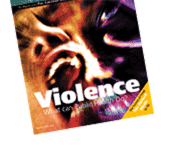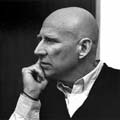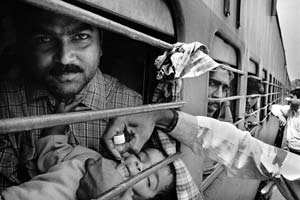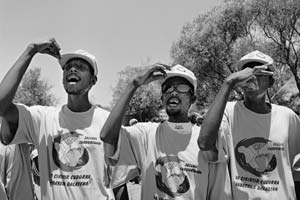
The Magazine of the Pan American Health Organization
Volume 8, Number 3, 2003


Chronicling the
End of Polio
by Paula Andaló

Sebastião Salgado has very nearly seen it all. The Brazilian photographer has traveled to more than 100 countries to document the human consequences of war and famine, the plight of manual laborers and the struggle of dispossessed farmers.
But even Salgado saw it as a oncein-a-lifetime opportunity when the United Nations Children's Fund UNICEF) approached him and proposed that he chronicle the lingering effects of polio in the 21st century and the global effort to eradicate the disease. When the effort succeeds, polio will be only the second human disease in history, after smallpox, to be eradicated entirely from the earth.

"I had no idea before they asked me to work on this book that polio still carried a stigma for so many people," says Salgado. "I generally try to provoke a debate with my photos, but it was different with this campaign. There was added value: I was given the historic task of recording a battle won, of offering hope. This book is a tribute to the efforts of health workers, to those who suffer from polio, and to the dignity of man."
Accepting the UNICEF assignment, Salgado began a journey in 2001 that would take him to five countries on two continents. Side-byside with health workers he traveled by boat on narrow rivers and by motorcycle down dusty roads to deliver vaccines to all-but-forgotten settlements where polio has remained endemic even as most of the world has eradicated the disease. He photographed polio victims, many of them now adults but many children too, documenting their efforts to live normal lives despite the disease's crippling effects. A selection of these poignant photos was exhibited at the Pan American Health Organization PAHO) and other venues before their publication earlier this year in book form as The End of Polio: A Global Effort to End a Disease (Bulfinch Press).

In its 3,500-year known history, polio has robbed millions of boys and girls, men and women of their freedom to move at will. Vaccines developed in the 1950s began to rein in the virus, dramatically reducing the disease's incidence through massive immunization campaigns.
The Americas region was the first to eradicate the wild strain of the virus and was declared polio-free in 1994. Luis Fermín, a 3-year-old Peruvian, was the hemisphere's last registered case. Western Europe was declared polio-free in 2002. But other regions have been less fortunate. Polio remains endemic in seven countries: Afghanistan, Egypt, India, Niger, Nigeria, Pakistan and Somalia. Twenty million people today are paralyzed as a result of the disease.
The Global Polio Eradication Initiative, launched in 1988 by the World Health Organization, the U.S. Centers for Disease Control, Rotary International and UNICEF, has brought the disease's end within sight. In just over a decade, the campaign helped reduce cases of polio paralysis from 350,000 to 500 in 2001, preventing an estimated 4 million cases of permanent disability due to the disease. Following in the footsteps of health workers through Congo, India, Pakistan, Somalia and Sudan, Salgado captured part of the historic last stretch of the effort to eradicate polio.

In the two years since Salgado completed his journey, the eradication drive has encountered new obstacles. The number of cases in India quadrupled in 2002 as a result of an epidemic in the country's north, but redoubled vaccination efforts have once again brought the number of cases down. This year, the disease spread from Nigeria to Ghana and Burkina Faso, prompting emergency vaccination campaigns in those countries as well as Togo, Benin, Cameroon and Chad. As of late October, however, the total number of cases worldwide for 2003 was down to 520.
It was three decades ago, one day in 1970, that Salgado's wife Leila put a camera in his hands. That simple act changed his life. A week later he bought one for himself, and within a month he had built a darkroom in his Paris home. Salgado left behind a career as an economist and embarked on a "road of no return," as he puts it, that transformed him into one of the most respected photographers in the world.

"When I looked through that lens, I discovered another world," says Salgado. "Photography took over my life. It took a while before it became my work and my reason for living-I think it was 1973 that I began my life as a photojournalist."
Salgado was born in 1944 in the Brazilian state of Minas Gerais. He studied economics at the University of São Paulo and, after leaving Brazil for political reasons, received his Ph.D. in 1971 from the University of Paris. It was in the French capital that he fell in love with that first camera. After a number of assignments as an economist -including a stint in Africa with the International Coffee Organization-he returned to Paris and decided to leave the world of economics behind once and for all.
Even in his new life, however, Salgado never lost his economist's perspective. It sharpened his eye as he observed the struggles of workers, refugees and migrants in an era of globalization. Traveling also helped shape his outlook.

"I travel 10 months out of the year. The only thing I haven't seen are the poles," says Salgado. "And I can attest to the fact that the essence of being human, wherever you go, is always the same. Human beings want dignity. No one is immune to pain. It's very hard to look at someone and think that he or she deserved a better life but because of geographical circumstances has had to suffer more than someone else."
Salgado is today involved in efforts to reforest his native state of Minas Gerais, where he bought a family ranch in 1990. He splits what little free time he has between the ranch-surrounded by monkeys, parrots and crocodiles -and his home in Paris.
Meanwhile, if the goal of a poliofree world by 2005 is to be met, those 520 cases must be brought down to zero. With his photographs, Salgado presents an admiring portrait of this final battle in one of the great wars for human dignity.
Paula Andaló is a journalist working in the Area of Public Information of the Pan American Health Organization in Washington, D.C.